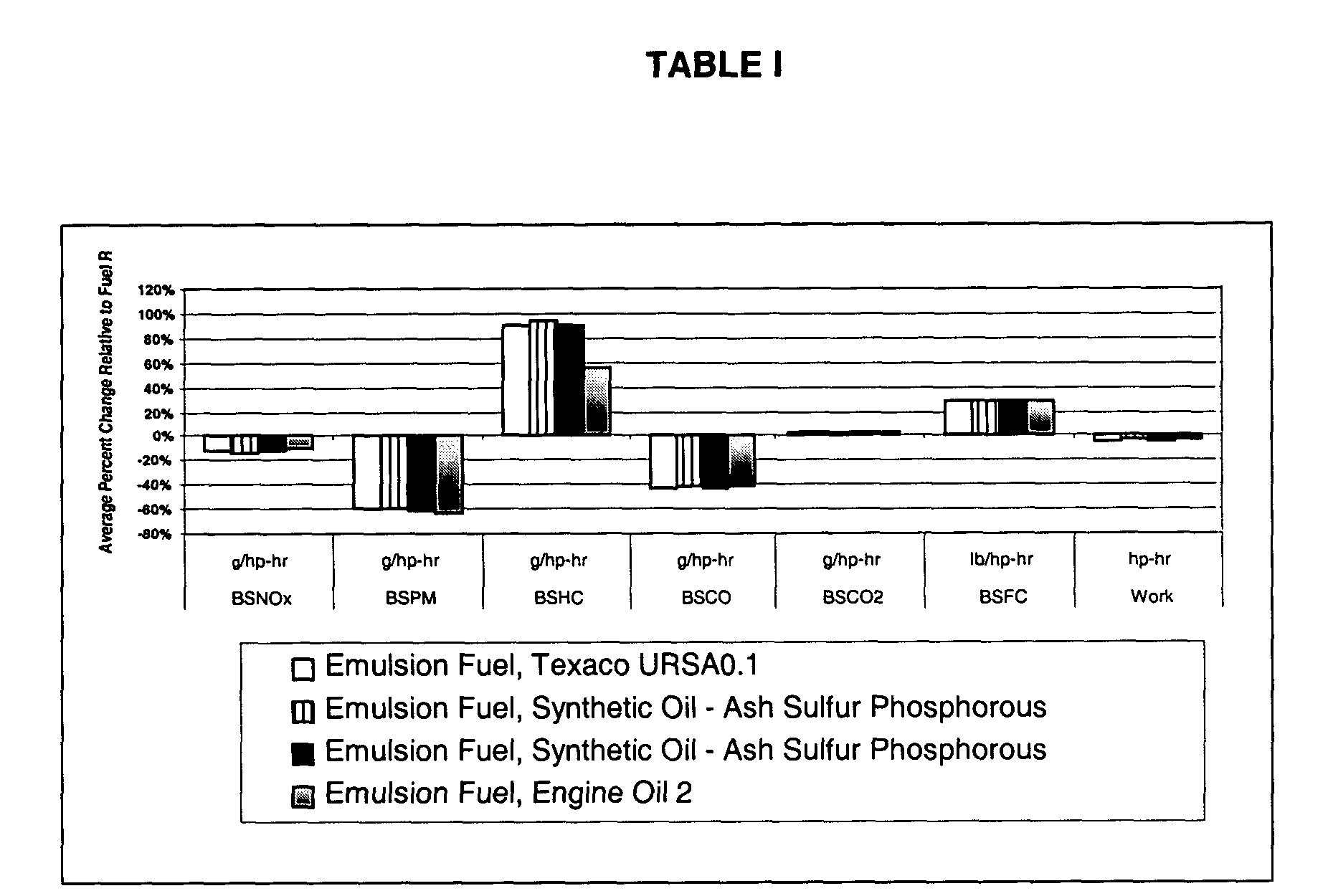Emulsified fuels and engine oil synergy
- Summary
- Abstract
- Description
- Claims
- Application Information
AI Technical Summary
Benefits of technology
Problems solved by technology
Method used
Image
Examples
specific embodiment
In order to move thoroughly illustrate the present invention the following examples are provided:
Engine Oil 1. The engine oil (sulfur free, phosphorous free, ashless) that has shown the performance advantage herein described:
10W-30, synthetic, poly alpha olefin (PAO)Composition: (These additives are expressed on an oil free basis)6.5%Succinimide dispersant based on direct alkylation(no chlorine) succan from high vinylidenepolyisobutylene (PIB)0.7%Nonylated diphenyl amine - oxidation inhibitor0.3%t-Butylated phenols - hindered phenol typeoxidation inhibitor
Engine Oil 2. The ashless engine oil (sulfur free, low phosphorous, ashless) that has shown the performance advantage herein described:
% wt.Composition (These additives are expressed on an oil free basis)90Poly alpha olefin synthetic base stock, 6 cSt SHF / MPC-15210Other synthetic base stock0.1Styrene-maleic anhydride copolymer, esterfied - pour pointdepressant0.7Nonylated diphenyl amine - oxidation inhibitor0.3Triphenyl pho...
example 1
Preparation of PIB Succinic Acid
A 2300 Mn poly(isobutenyl) succinic anhydride (about 9410 g, about 6.84 eq C═O) was charged to a 12-liter spherical 4-neck flask equipped with a temperature controller regulating a rheostated heating mantle and a 20 thermocouple in a glass thermowell. The material was stirred at about 45° C. and an above-surface N2 sweep was set at about 1 SCFH (standard cubic feet per hour). The mixture was heated to about 90° C. Deionized water (about 184.8 g, about 20.54 equivalents) was then added over about 10 minutes. The mixture was heated at about 90° C. for about 2 hours. Infrared analysis showed acid peak at 1714 cm−1− with a slight anhydride or lactone shoulder at 1786 cm−1−. The mixture was cooled to about 50° C. and discharged.
example 2
Simultaneous Preparation of Both Salts
Oleic acid (about 2450 g), 2-ethyl hexyl nitrate (about 3420 g), and hydrolyzed 2300 molecular weight PIBSA (about 2410 g, about 50% active chemical by weight) (from Example 1) was charged to a 12-liter spherical 4-neck flask equipped with a temperature controller monitoring a thermocouple in a glass thermowell. The mixture was stirred at room temperature under a nitrogen flow at about 1 SCFH, and the materials were mixed until homogeneous. Diethylamino ethanol (about 1110 g) was charged over 1 hour, and a mild exotherm was observed. The resulting material was a solution of carboxylate salts in 2-ethylhexyl nitrate.
Some illustrative water-blended fuel compositions within the scope of the invention are disclosed Table 1. The amounts are in parts by weight.
TABLE IComponentsEmulsion AEmulsion BEmulsion CDiesel Fuel77.8077.5175.30Water20.0020.0016.80Surfactant 11 0.5261.160.526(˜50% active)Surfactant 220.7240.3820.7242-ethyl hexyl nitrate0.714...
PUM
 Login to View More
Login to View More Abstract
Description
Claims
Application Information
 Login to View More
Login to View More - R&D
- Intellectual Property
- Life Sciences
- Materials
- Tech Scout
- Unparalleled Data Quality
- Higher Quality Content
- 60% Fewer Hallucinations
Browse by: Latest US Patents, China's latest patents, Technical Efficacy Thesaurus, Application Domain, Technology Topic, Popular Technical Reports.
© 2025 PatSnap. All rights reserved.Legal|Privacy policy|Modern Slavery Act Transparency Statement|Sitemap|About US| Contact US: help@patsnap.com



